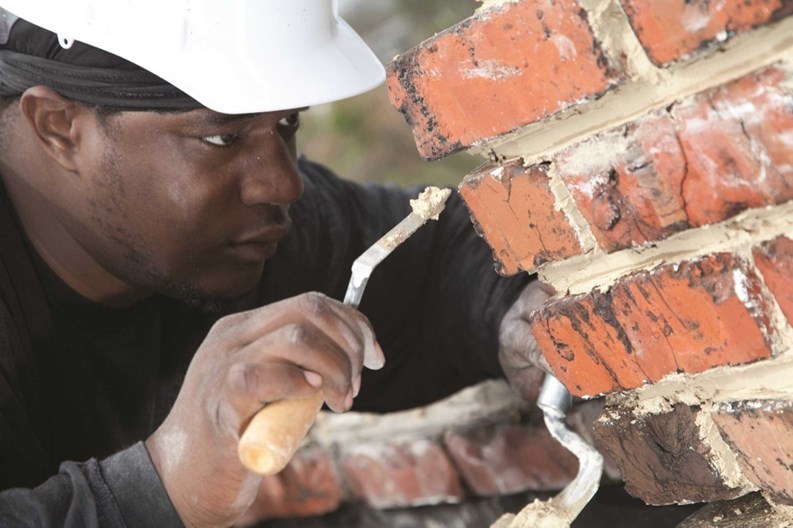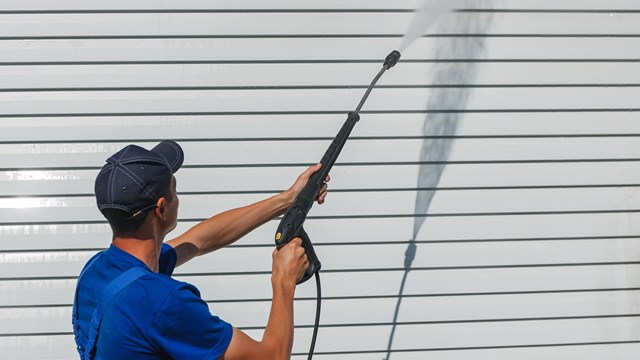Brickwork is everywhere across the Chicagoland area. Around since the early 1600s, the popular building material is commonly used not only because of its aesthetic appeal, but also because of its practicality. Naturally weatherproof, bricks protect well against wind, fire, and a large amount of water damage. Sounds like a magical building material, right?
Well, not quite. What many condominium associations don’t realize is that there's a fair amount of maintenance that goes into brickwork. From repointing and caulking to cleaning and sanding—brick walls are an investment, and if taken care of appropriately can last beautifully for generations.
The Brick Basics
Not all bricks are created equal. Bricks come in a myriad of different shapes, styles and textures. There are two basic types says Chuck McCrimmon, president at Dakota Evans Restoration Inc., a restoration contractor in Palatine. “There are common bricks, which are clay-fired units. They are less decorative and less expensive, so they are more commonly used on the sides and rear of the buildings not facing the street. Then there is face brick, containing more shades, so you can get a harder face and introduce different colors and textures into them. These are what you would use for the street-facing side of the building,” he explains.
Bricks are also graded SW (severe weathering as we see here in the Midwest and Northeast), MW (for the rest of the country, and NW, which is only to be utilized on the interiors, he adds.
These days, though, a majority of the walls are made of brick veneers. What’s that mean? Essentially, the brick you see on the outside of the building is only one brick thick, and is anchored to the wall beneath. Behind that layer of brick, there is a cavity or airspace roughly 1 to 2 inches wide, and then a backup wall behind that which is generally made of concrete block or steel studs with gypsum sheeting. Compared, for example, to old-school buildings—specifically those built before 1950—which often boasted walls made of one to two feet of layered brick, this is a completely different ballgame.
Why the veneers? Well, in the long run the brick face is much easier to take care of, and since it uses less mortar and requires less repointing, is more cost effective. However, these veneers are much more porous than solid brick structures, which can lead to a slew of waterproofing problems, says Robert Reese, president of AAA-1 Masonry and Tuckpointing in Chicago.
Key Maintenance for Bricks
Bricks are one of the sturdiest building materials and are a popular material for constructing homes. But despite what many residents and management companies believe, brick is not entirely maintenance-free. It does possess a couple critical needs.
The possibility of water damage affects the pointing between the bricks. Over time, the weather and various other elements cause the original mortar between the bricks to appear unattractive and dingy. This is where tuckpointing comes into play. It involves replacing the cracked or eroded mortar, which is the white or gray gluey material between bricks that holds them together. “Tuckpointing is grinding out the bad, crack-eroded mortar joints, usually three-quarters-of-an-inch deep and installing new matching mortar,” says John Holton, vice president of Holton Brothers, Inc., a building restoration and masonry contractor in Arlington Heights.
“You want to be looking especially for cracks emanating from the top corners of the windows because that may indicate that there are lintel issues,” explains Reese. “Lintels are pieces of steel that are a little wider than the width of a window and that hold the masonry up, supporting the masonry above a window, so the weight of the bricks doesn't crush the window. It's kind of like a suspension bridge.”
McCrimmon adds that proper tuckpointing techniques should last about 25 years.
Open coping joints can also pose a problem for brick exteriors. “Coping joints are the caps that sit inside the walls so we want to keep water from infiltrating through those coping joints,” says Holton. The solution would be to caulk the joints so they are properly sealed.
Caulking is also recommended around windows and doors, says Reese. “Caulk around windows and doors is really important. You want a product that is appropriate for the substrate it's supposed to bond to. So when I seal windows, I need a product that's going to bond the wood and brick. Most homeowners want a one-part silicone or one-part polyurethane sealant. That means the whole product gets shot out of one tube. There are two-part products where you basically put two tubes right next to each other and they mix when they come out, but they've been co-mingled. There's like an A and a B,” he says.
Although sturdy, reliable building components, unsealed bricks do tend to absorb water. In older buildings made of brick, this wasn’t as much of an issue because they were used for working environments like textile mills or rope manufacturing facilities. Reese recommends waterproofing with a 100 percent silane product. “The 100 percent silane solutions have a greater than 99 percent moisture transitivity rate so it's like liquid vortex. The water droplets can't get in or certainly can't get in very far and it breathes beautifully,” he says.
Though some residents and even property managers may be tempted to paint the brick, industry experts caution against it. “You don't want to paint the brick because you will smother the surface of it. And when you smother it, it can't breathe. Therefore, when water gets into the wall, it can't get out, so now you have a wet wall, you got winter coming and you're freezing and thawing, and so the water is expanding and contracting inside the building unit, the major unit, as opposed to escaping,” says Reese.
For some condominium owners, the aesthetic that led them to buy a home in an older, renovated brick building may later create a challenge in maintaining the property. The old brick walls may have character, but they need occasional TLC. “One of the challenges is having the mentality of keeping up on the maintenance. People may think that once you do [the maintenance] once, you can forget about it for 20 to 30 years. Actually, a building should be looked at every five years just for preventative measures,” says Holton.
So how often do these repairs need to take place? According to McCrimmon, here in the Midwest caulking should last 8-11 years and waterproofing, depending on the type and application is 5-10 years.
Of course, it’s important to take into account how expensive these repairs may be. Accessing brick structures often requires scaffolding, lifts, and other sorts of heavy machinery.
“Access to walls can be problematic. Generally it will be with built up scaffolding or with suspended/cantilevered scaffolding from the roof. Ladders are a means to get somewhere and are not a safe working platform for masonry restoration,” he says.
Getting it Done
When it comes to picking the right person for your brick work needs, it’s very important to do your research. Holton suggests seeking out references from previous clients for any prospective contractor.
Some initial questions condominium boards can ask when seeking out the right contractor for a big job: What are we looking to accomplish here? Do we need structural repairs? Are we simply applying sealants? Or do we need someone who can start from scratch, soup to nuts? Think of it this way: If you are going to be shelling out a lot of money for a large project, then you want to make sure your money is well spent.
In Chicago, a contractor needs to have a mason's license to work in the city, says Holton.
Environmental Issues
As with any construction project, there are a few environmental issues to be concerned with when it comes to bricks. First and foremost, airborne dust may result from the mortar joints or sealant removal. There are, however, precautions that contractors can take based on the surroundings to prevent inhalation.
“When we grind the mortar for the tuckpointing, that dust has silica that gets put in the air. There are dust containment methods that we use such as tarps and equipment to contain the dust,” says Holton.
Additionally, chemical runoff from masonry cleaning or sealing operations is an important hazard to watch out for. The last thing you want is hazardous materials going in to local sewers. Additionally, it’s important to carefully dispose of all hazardous materials involved in the process, such as old sealants, lead paint and any asbestos-containing material.
The Latest Methods: Old vs. New
There have been many improvements in the quality of bricks and assembly of brickwork since their arrival in the early 1600s.
“Technologies in water repellants have changed. Originally the thought was that any moisture infiltration was bad, so the original silicone agents were designed with that in mind. Unfortunately, they were non-breathable and once water was trapped inside the wall, it couldn’t get out. A number of buildings suffered from the subsequent damage. The new agents are breathable, allowing for the exit of water vapor from the wall,” explains McCrimmon.
Holton adds, “There are some new sealers out on the market. Those are a protective coating going on over the masonry to protect moisture infiltration.”
In short, brickwork may be difficult to work with at times, but the material has become a serious staple within Chicago architecture. Potential residents are looking for buildings and communities that boast a certain aesthetic. If done correctly and cared for appropriately, brickwork can make a condominium complex more desirable and increase its value in the long run.
Emily Abbate is a freelance writer and a frequent contributor to The Chicagoland Cooperator. Editorial Assistant Maggie Puniewska contributed to this article.







Leave a Comment